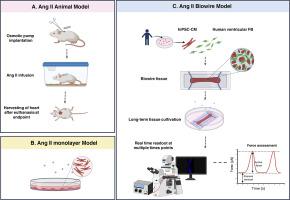Journal of Molecular and Cellular Cardiology ( IF 4.9 ) Pub Date : 2021-06-30 , DOI: 10.1016/j.yjmcc.2021.06.012 Erika Yan Wang 1 , Uros Kuzmanov 2 , Jacob B Smith 3 , Wenkun Dou 4 , Naimeh Rafatian 5 , Benjamin Fook Lun Lai 1 , Rick Xing Ze Lu 1 , Qinghua Wu 1 , Joshua Yazbeck 1 , Xiao-Ou Zhang 6 , Yu Sun 4 , Anthony Gramolini 2 , Milica Radisic 7

|
Angiotensin II (Ang II) presents a critical mediator in various pathological conditions such as non-genetic cardiomyopathy. Osmotic pump infusion in rodents is a commonly used approach to model cardiomyopathy associated with Ang II. However, profound differences in electrophysiology and pharmacokinetics between rodent and human cardiomyocytes may limit predictability of animal-based experiments. This study investigates the application of an Organ-on-a-chip (OOC) system in modeling Ang II-induced progressive cardiomyopathy. The disease model is constructed to recapitulate myocardial response to Ang II in a temporal manner. The long-term tissue cultivation and non-invasive functional readouts enable monitoring of both acute and chronic cardiac responses to Ang II stimulation. Along with mapping of cytokine secretion and proteomic profiles, this model presents an opportunity to quantitatively measure the dynamic pathological changes that could not be otherwise identified in animals. Further, we present this model as a testbed to evaluate compounds that target Ang II-induced cardiac remodeling. Through assessing the effects of losartan, relaxin, and saracatinib, the drug screening data implicated multifaceted cardioprotective effects of relaxin in restoring contractile function and reducing fibrotic remodeling. Overall, this study provides a controllable platform where cardiac activities can be explicitly observed and tested over the pathological process. The facile and high-content screening can facilitate the evaluation of potential drug candidates in the pre-clinical stage.
中文翻译:

用于进行性非遗传性心肌病临床前药物评估的器官芯片模型
血管紧张素 II (Ang II) 在各种病理状况(例如非遗传性心肌病)中提供关键介质。啮齿动物的渗透泵输注是一种常用的方法来模拟与 Ang II 相关的心肌病。然而,啮齿动物和人类心肌细胞在电生理学和药代动力学方面的巨大差异可能会限制动物实验的可预测性。本研究调查了器官芯片 (OOC) 系统在 Ang II 诱导的进行性心肌病建模中的应用。构建疾病模型以以时间方式概括心肌对 Ang II 的反应。长期组织培养和非侵入性功能读数能够监测对 Ang II 刺激的急性和慢性心脏反应。除了绘制细胞因子分泌和蛋白质组学图谱外,该模型提供了一个定量测量动物中无法识别的动态病理变化的机会。此外,我们将此模型作为测试平台来评估针对 Ang II 诱导的心脏重塑的化合物。通过评估氯沙坦、松弛素和萨拉卡替尼的作用,药物筛选数据表明松弛素在恢复收缩功能和减少纤维化重塑方面具有多方面的心脏保护作用。总的来说,这项研究提供了一个可控的平台,可以在病理过程中明确地观察和测试心脏活动。简便且高内涵的筛选有助于在临床前阶段评估潜在的候选药物。









































 京公网安备 11010802027423号
京公网安备 11010802027423号